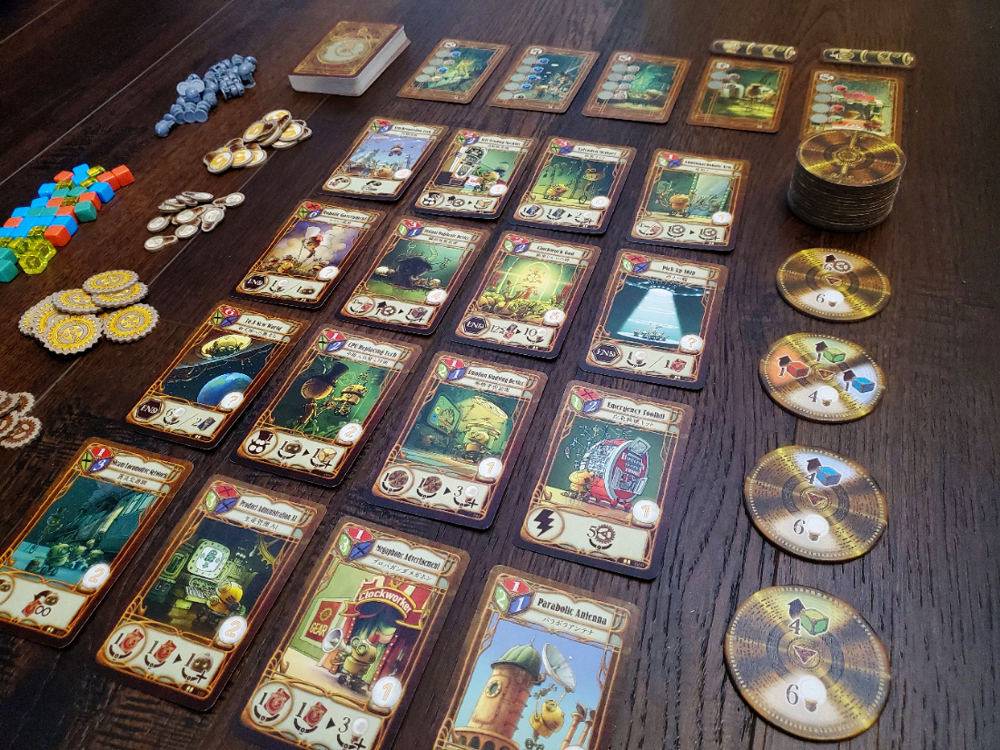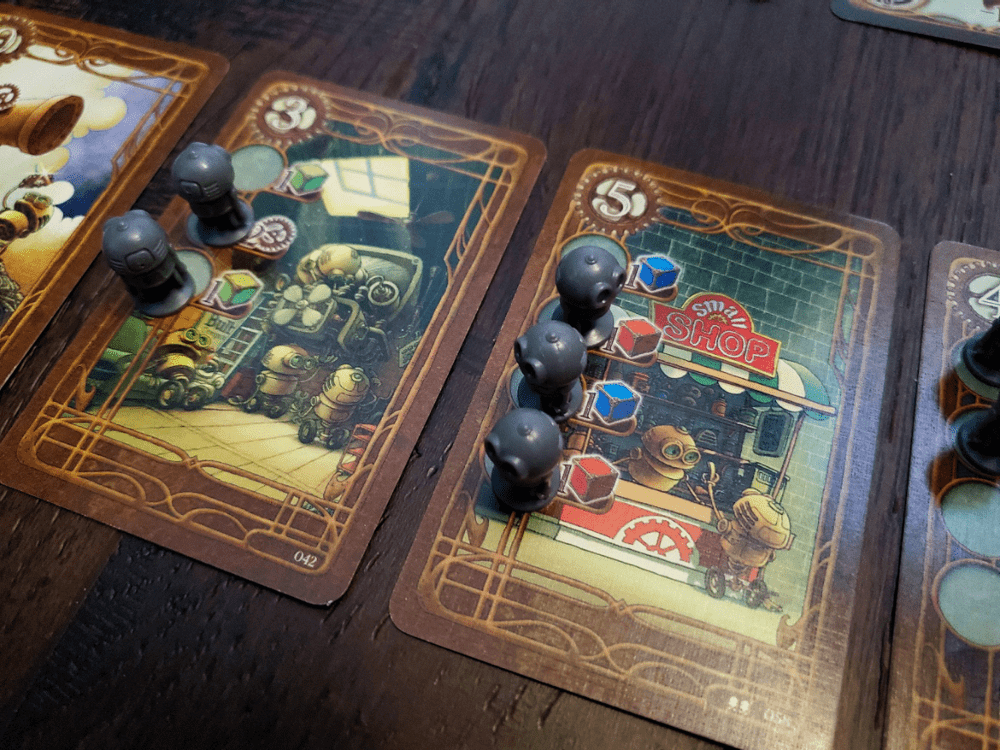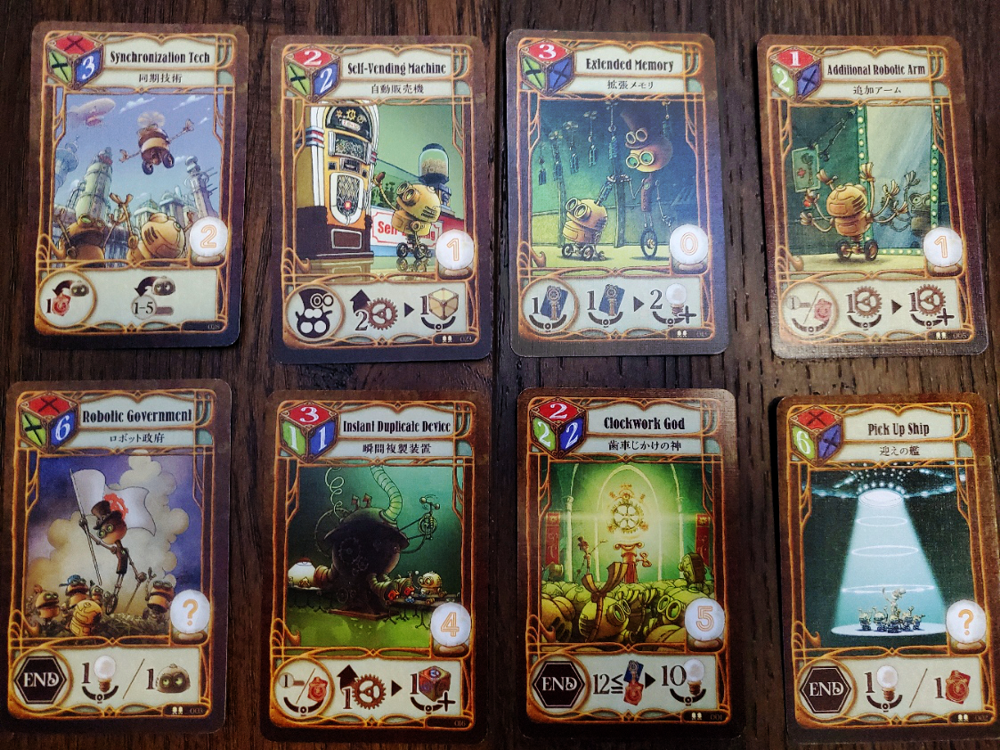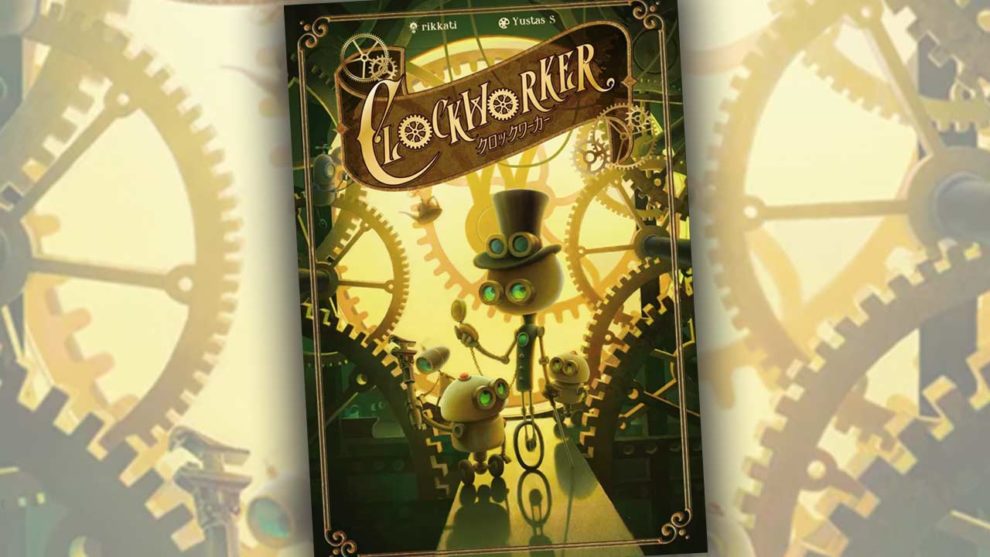Nothing threatens disappointment like a beloved movie on a game box.
But when a game, completely free of the licensing and likeness restrictions inherent in intellectual properties, kinda sorta reminds me of a beloved movie without actually being that movie—now that’s just a mountain of potential waiting to be explored.
Imagine if you will the Earth of the distant future, a planet abandoned after the disaster of human advancement brought desolation. Imagine also a race of quirky and loveable animated robots left behind to deal with the mess. These robots, deriving their power from who-knows-where, begin to collect and reignite the machines of earth’s past, awakening a new and charming culture that reinterprets the human past through a distinctively robotic lens.
The idea just screams five or six degrees wide of something I’ve heard before… and I love it. Then I look at the box art and see in those little domed heads something else eight or ten degrees wide of something I’ve seen before… and I love it even more!
 One of the newest releases from Hobby Japan, Clockworker explores the lives of bulbous robots with goggled eyes and various sorts of wheeled legs. A worker retrieval game from the mind of Japanese designer Rikkati, Clockworker challenges players to visit locations; repair, reinterpret, and operate machines; all while sifting through Records in pursuit of becoming the leader of Earth’s next era.
One of the newest releases from Hobby Japan, Clockworker explores the lives of bulbous robots with goggled eyes and various sorts of wheeled legs. A worker retrieval game from the mind of Japanese designer Rikkati, Clockworker challenges players to visit locations; repair, reinterpret, and operate machines; all while sifting through Records in pursuit of becoming the leader of Earth’s next era.
Charming mechanisms
Clockworker is a tableau building game that centers around the Junkyard, a collection of Location cards, Artifact cards, Record tiles, and a miscellany of energy pellets, gears, light bulbs, and the cutest micro-robots you’ve ever attempted to handle. Of course, this Junkyard is slightly better organized than the name suggests.

Each player begins the game with a starting Location card, a half dozen robot mini-minis and a number of gears based on the player count. The object of the game is to collect the most victory points, represented by light bulbs, from the Artifacts and Records in the Junkyard. Acquiring these cards and tiles requires energy pellets. Energy pellets come from Locations. And Locations are reached via gears and mined by robots.
Though the rules speak of worker placement, I would call Clockworker a worker retrieval game. Rather than collecting resources upon sending the robots, players begin each turn by retrieving the topmost robots from each of their Location cards, collecting the promised resources there. Resources may include gears, energy pellets, or more robots. While this may seem like a minor difference in the mechanic, the tension within the game is entirely dependent upon the reversal. Those who have played Raiders of the North Sea are familiar with the effect of the flip.
After the retrieval, players then have six available actions, from which they must choose one. Recover allows the retrieval of one additional robot for a resource. Dispatch is the robot placement action in which players may load any number of their robots to a Location card beginning with the topmost available spot and working down the card without skipping over an unoccupied space.
 Operation is the name for spending gears to acquire new Location cards into their tableau. The Locations in the Junkyard function like a typical marketplace: as one card is purchased, the remaining cards slide towards the end with bonus spaces marked by batteries. The leftmost battery space can be purchased at a discount. The next card is full price, but grants the resource of its topmost space upon purchase. When a Location is purchased, it may be filled with robots á la the aforementioned Dispatch rules as an added perk.
Operation is the name for spending gears to acquire new Location cards into their tableau. The Locations in the Junkyard function like a typical marketplace: as one card is purchased, the remaining cards slide towards the end with bonus spaces marked by batteries. The leftmost battery space can be purchased at a discount. The next card is full price, but grants the resource of its topmost space upon purchase. When a Location is purchased, it may be filled with robots á la the aforementioned Dispatch rules as an added perk.
Repair is the term for purchasing an Artifact card from the grid in the center of the Junkyard. Artifact cards cost some combination of energy pellets and introduce either a special ability or a lucrative endgame scoring bonus. Artifacts form the engine in a player’s tableau. The proper combination of cards could create a devastating one-two punch (and maybe three and four as well). Between Locations and Artifacts, the purchase of a twelfth card into any tableau serves as the first possible endgame trigger.
 Communicate involves purchasing Records—resources for points, that’s all. The stack of Records is set up each game as the second endgame trigger. Should the END Record see the light of day, the current round will be the last. Of course, there are always enough Records after the END to resolve the final turn.
Communicate involves purchasing Records—resources for points, that’s all. The stack of Records is set up each game as the second endgame trigger. Should the END Record see the light of day, the current round will be the last. Of course, there are always enough Records after the END to resolve the final turn.
The final and rarely taken action is called Charge. Simply stated, the player gains two gears when faced with no other appealing option. In all my games thus far, I’ve yet to see someone take this particular action.
Mechanical charm
I went hunting for Clockworker, which was easily my most anticipated game from Essen Spiel 2022. I set up an account on Amazon.jp entirely because of this one peculiar title with its whimsical aesthetic and the promise of a slight twist on one of my favorite game mechanics. When I couldn’t find a trade copy, I broke down and filled out an international order (along with several other titles, including the classic Rumble Nation and 2022 Spiel des Jahres nominee SCOUT) and set myself to wait.
I bring this up because I think it’s only fair for you to know my level of anticipation for these little robots. I’m not sure why I’ve been so drawn into the prospect of the setting and story of Clockworker, but I have. And, truth be told, the little fellas haven’t disappointed, though the game is far from perfect.
The artwork is so very delightful, though I would also classify it as underwhelming. Each of the cards is an off-balance masterpiece of sorts. But the artwork is busy and therefore takes a bit of time to appreciate. I fear the charm is lost in the buzz of the mechanisms because the game moves somewhat quickly, most often reducing the various cards to their iconography.
The iconography is functional, but also falls under the category of busy. As an example, the symbol for “when you collect…” is an interrupted arc with a dot in the center. This may be a cultural choice, but there are a number of more intuitive ways to signify that action. Across the board, the icons suffer similar tangles. Even after several plays, I find myself re-learning certain bits every time I bring it to the table.
The components are standard fare. I’ve enjoyed the multi-lingual blend inside the box. My one frustration, but one that I understand from a cost-efficiency perspective, is the size of the robots. Heretofore, I’ve lovingly used modifiers like mini- and micro- because they are almost too small to handle. I find myself fumbling about, knocking the figures out of place with my fingers as I try to retrieve them one by one from their close quarters. I can’t say it’s a complaint, though I’ve heard whispers here and there during play.
![]() But the mechanisms!! I love the worker retrieval system in Clockworker. Here is the rub with turning traditional worker placement upside down: in order to gain resources, you must somehow get the worker robots onto the cards. Now this happens a couple ways. One is to burn a turn placing them—a potentially costly maneuver in a game that moves at a healthy pace. Once you have six cards in your tableau, you can load two cards, and two of the Artifacts could also boost your robot Dispatch, but a turn is a turn. The other way is to buy a new Location and load it immediately, which is fine. But the game only allots twelve spaces in your tableau. Unless you’ve built an engine that rewards the purchase of extra Locations, there are often better uses for the resources. Still, it must be done!
But the mechanisms!! I love the worker retrieval system in Clockworker. Here is the rub with turning traditional worker placement upside down: in order to gain resources, you must somehow get the worker robots onto the cards. Now this happens a couple ways. One is to burn a turn placing them—a potentially costly maneuver in a game that moves at a healthy pace. Once you have six cards in your tableau, you can load two cards, and two of the Artifacts could also boost your robot Dispatch, but a turn is a turn. The other way is to buy a new Location and load it immediately, which is fine. But the game only allots twelve spaces in your tableau. Unless you’ve built an engine that rewards the purchase of extra Locations, there are often better uses for the resources. Still, it must be done!
A properly loaded set of Locations can unleash a mad flurry of resources which, if precisely timed, can mean a barrage of purchases in consecutive turns that push the game towards a glorious conclusion. A set of languishing Locations starved for robots or Locations that run dry as the endgame draws nigh could mean the difference between victory and defeat. As the game rolls on, these pressures come alive and they are beautiful.
Every Artifact card included in Clockworker is available in every game. On the one hand, this means there are only so many engine combos available to try, a sure sign of the game’s limitations. On the other hand, when a group of players sits to the table, the open knowledge of the Junkyard’s contents adds a race within a race as players are then drawn to study the available Locations and the resources they’ll provide in order to determine a strategic thrust toward acquiring the preferred Artifacts. I’ve grown to appreciate the openness and the responsiveness it requires. I wouldn’t turn down an expansion pack of Artifacts, but I don’t mind the limitation right now.
Then again, with the Records sitting off to the side, it’s entirely possible that a player won’t engage the Artifacts much at all except to possibly bolster the value of the Records themselves. Watching a player plough through the Records is frightening because the other piece of open information is the location of the END Record. While the endgame in Clockworker drops like a rock, everyone sees it coming if their eyes are open. I kinda dig that brand of pressure.
Clockworker is a fun little efficiency race. Resources are constantly flying around the table as players collect and spend. In fact, we set up piles on both sides of the table just to keep all the bits in reach. Turns are over lickety-split with only a quick retrieval and a single action. The games are often fairly tight on the scoreboard, with just about everyone wishing (in the best possible way) they had one more turn. I wish the thematic bits were stronger, but they are still there if you’re looking. Even the retail price is manageable and perfectly reasonable for the amount of game inside the box.
Availability, however, is a killjoy. Depending on your geography, Clockworker may be harder to get your hands on right now, as my experience suggests. If you are an Amazon.jp customer, toss it on your next order and wait gleefully for the international package. Otherwise, keep your eyes open for Hobby Japan at the next Con or watch the used market. You won’t see my copy on there, but if you see one, it’s worth hunting down for a play or two just to taste the international flair and savor the quirky dystopian mini-robot goodness.











Add Comment